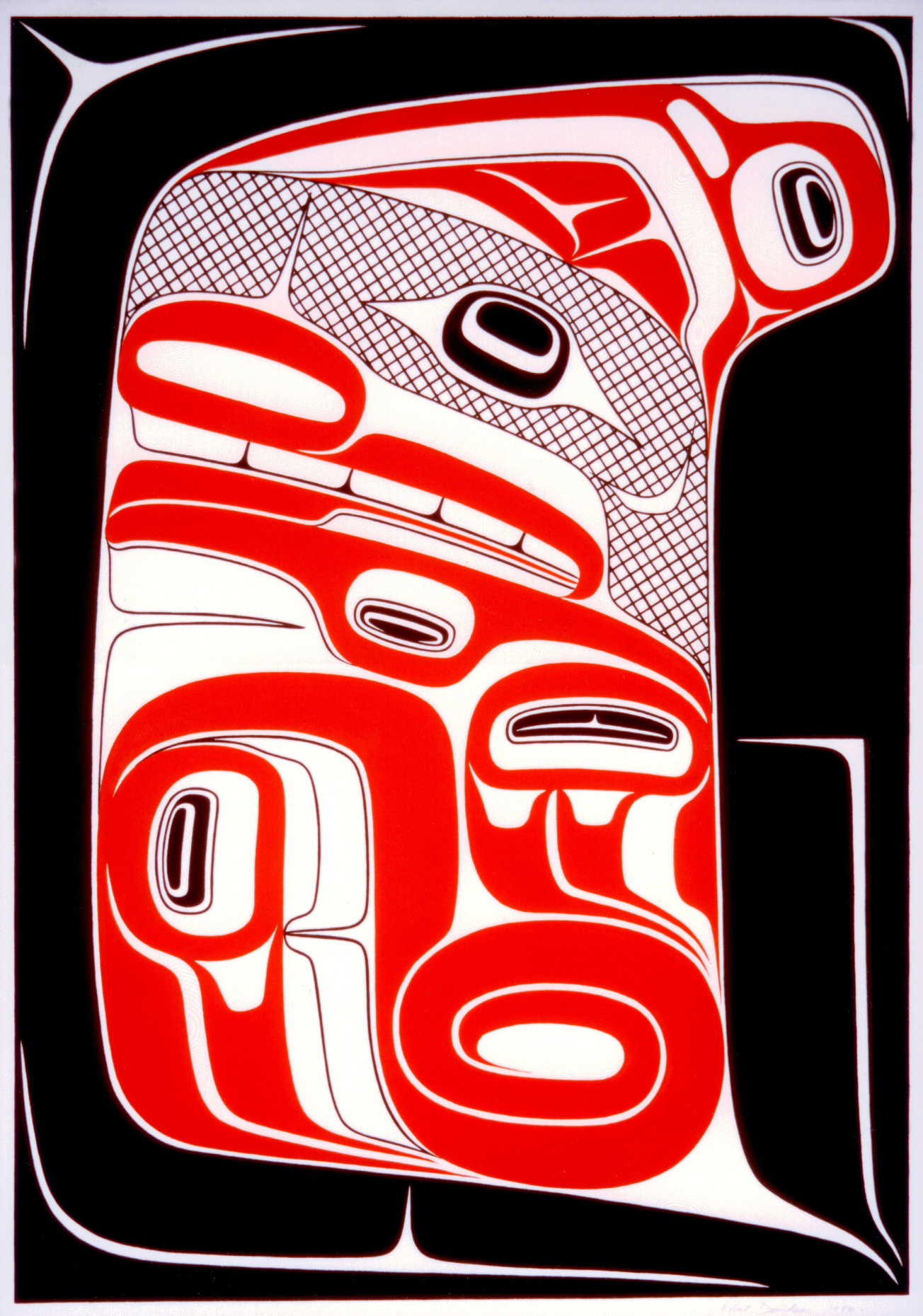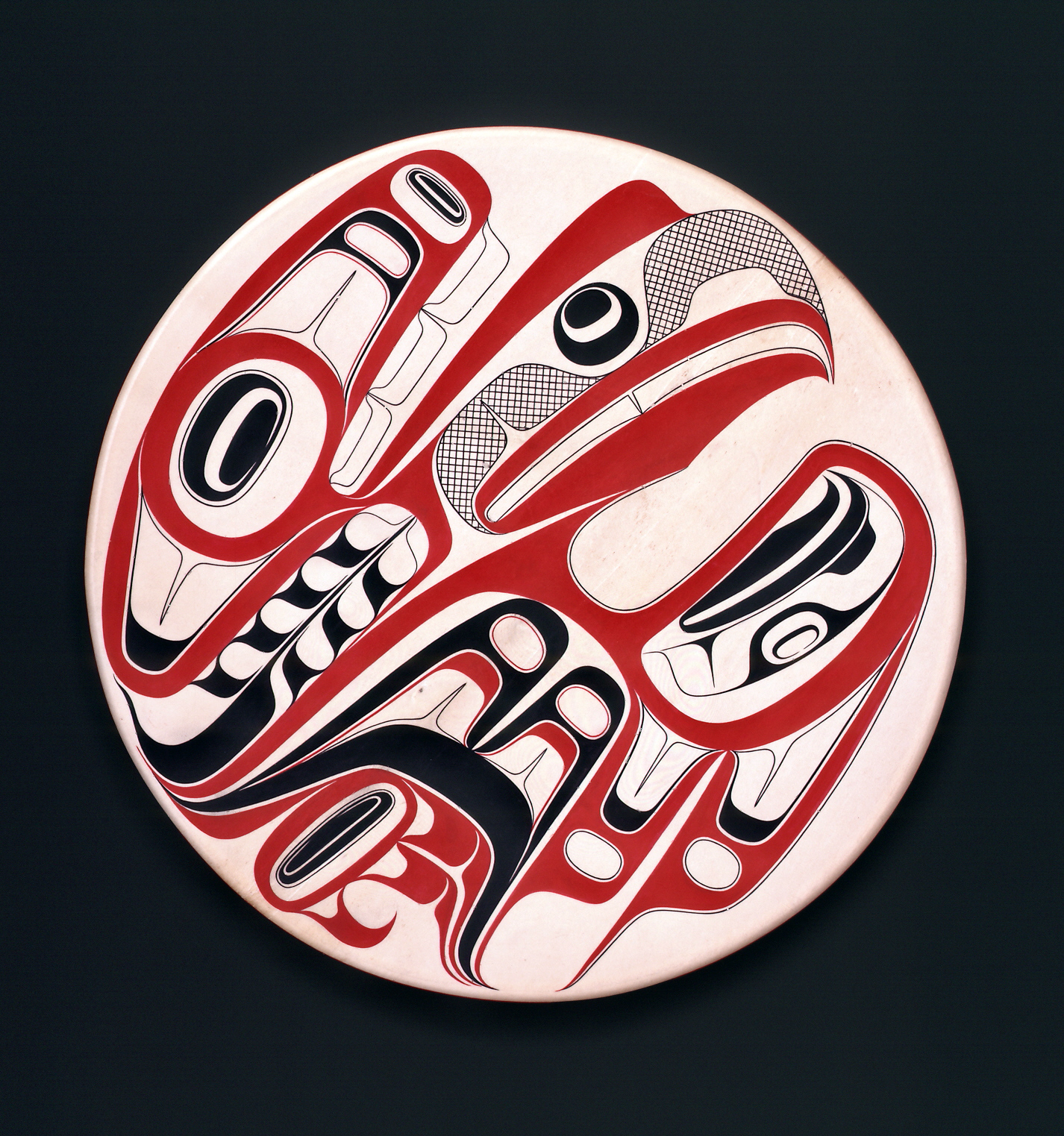
Robert Davidson, Eagle Transforming, 2002.

Robert Davidson, Eagle Transforming, 2002.

Robert Davidson, The Happy Blowhole, 1992. Cast Bronze.

Robert Davidson, Seawolf in Its Own Dorsal Fin, (2/99), 1983. Serigraph.

Robert Davidson, Eagle drum, 1991.

Robert Davidson, Untitled copper with eagle design, 1995.
Robert Davidson:
Exhibition Subtitle
Eagle of the Dawn, Northwest Coast Master
An exhibition of sculpture, works on paper, hide drums, cloth, copper, and woven spruce-root basketry by renowned Haida artist Robert Davidson. Works by Reg Davidson, Claude Davidson, Robert Davidson Sr. and Charles Edenshaw are also on display.
Artist Talk & Reception:
April 17, 2008 @ 6:30pm
The Artist:
Robert Davidson is one of Canada’s most respected and important contemporary artists. A Northwest Coast native of Haida descent, he is a master carver of totem poles and masks and works in a variety of other media as a printmaker, painter and jeweler. He is also a leading figure in the renaissance of Haida art and culture. Robert Davidson is best known as an impeccable craftsman whose creative and personal interpretation of traditional Haida form is unparalleled.
Robert Charles Davidson was born November 4, 1946 in Hydaburg Alaska. His Haida name is Guud San Glans/Eagle of The Dawn. He moved with his family to Massett on Haida Gwaii (Queen Charlotte Islands) in 1947 and lived there until 1965 when he moved to Vancouver, to complete his education at Point Grey Secondary School. It was here that he first learned the fundamentals of silk-screening. In 1966 he met Bill Reid and through Reid, he met anthropologist Wilson Duff, artist Bill Holm and learned much about the Haida people and their art. In 1967 he enrolled in the Vancouver School of Art, a place he credits for developing his drawing and design skills.
Robert Davidson was surrounded by fine carving from an early age as both his father, Claude Davidson and grandfather, Robert Davidson Sr., were respected carvers in Massett. His great grandfather was the famed Haida carver Charles Edenshaw. Robert began carving at the age of 13 when his father insisted he carry on the family artistic tradition. Since that time, he has continued to explore the carved form in a variety of traditional and non-traditional media including bronze. He is now the consummate Haida artist whose strong rhythms and personal style are recognizable and sought the world over.
For more than thirty years, Robert Davidson has worked as an artist and has produced an internationally acclaimed body of work. His work is found in a number of important private and public collections including the National Gallery of Canada in Ottawa, the Vancouver Art Gallery, the Canadian Museum of Civilization in Hull, Quebec, the Southwest Museum in Los Angeles and the Artists for Kids Gallery in North Vancouver. He has also received many honours for his accomplishments. In 1995 he received the National Aboriginal Achievement Award for his contribution to First Nations art and culture. He holds honourary degrees from the University of Victoria, Simon Fraser University in Burnaby, the Southern Methodist University in Dallas, Texas and the Emily Carr Institute of Art and Design in Vancouver. He has received the Order of British Columbia and in 1996 was awarded the prestigious Order of Canada.
The Eric Milliren & Steven Muchnick Collection:
It is a pleasure for both of us to work with the curator and director of the C.N. Gorman Museum to present this show of Robert Davidson’s work, along with a few works by each of four of his family members, namely, his brother Reg, father Claude, grandfather Robert, Sr., and great grandfather Charles Edenshaw (who is considered the greatest Haida artist of the late 19th and early 20th centuries). It is also a pleasure to have Robert and his wife Terri-Lynn Williams-Davidson as friends.
Our interest in Northwest Coast native art began in October 1985 when Steve was on a trip to Boston with a plane change in Chicago. He bought the current issue of Islands at O’Hare and found an article titled “Totem Pole Islands” that focuses on Haida Gwaii (the Queen Charlotte Islands, ancestral home of the Haida First Nation, to use the Canadian term) and the other islands off the coast of British Columbia and that was replete with photographs of Northwest Coast art. The impact of the article was such that he simply fell in love with Haida art and, over time, the art of the Tsimshian and Tlingit.
Eric had a slight familiarity with the art beginning when he was six or seven because his father, the leader of a local Boy Scout troop, had turned a segment of a dead tree into a rather goofy-looking totem pole that was erected in their front yard.
Steve purchased the first piece in our collection in November 1985, and, when we became a couple in 1988, we found that we shared excitement about Northwest Coast art. We started collecting in earnest and about mid-1990, Eric pointed out that we were accumulating a collection of interesting pieces but that the collection had no overall organizing theme. We decided to begin collecting older pieces in addition to modern ones. Over time the collection has grown to over 225 pieces in various media and about 750 publications.
